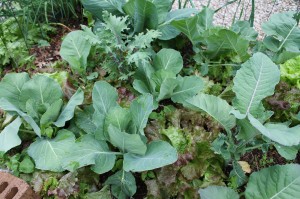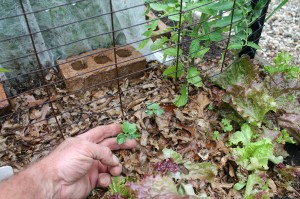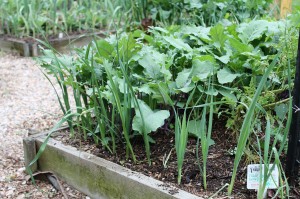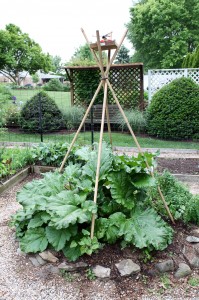Yield Boosters
June 11th, 2013
I try to milk every last little bit of production space out of my vegetable garden.
From the design itself to what and how I plant, my goal is to get the most out of the least space with the least work.
You’ve heard of Square Foot Gardening? I do Square Inch Gardening because a speck of soil is a terrible thing to waste.
I’ve picked up a lot of little yield-boosting ideas over the years, so this week I thought I’d share some of them with you:
1.) Planting in blocks instead of rows right off the bat increases yields. But I maximize even the block-plantings by inserting small, fast-growers in the gaps among the transplants.
Example: When I plant my broccoli, cabbage and cauliflower plants about 15 to 18 inches apart, I insert a lettuce seedling or plant a few radishes in each gap. By the time the cole crops expand over the space, the lettuce and radishes are ready to pick.
2.) Similarly, I interplant tomato transplants with cucumber seeds. I use concrete-reinforcing wire tied to metal stakes as my “tomato walls,” and this support is also ideal for climbing cuke tendrils.
The cukes wind their way up along with the growing tomato foliage, and I end up picking bonus cucumbers in space that otherwise would be used solely by tomato leaves.
Even a few plants give plenty of cucumbers for fresh eating, usually starting before the tomatoes ripen.
3.) Those tomato walls are spaced 1 foot in from the edge of my beds to allow soil space for the tomato roots to stretch out.
I’ve found that shallow-rooted lettuce, mesclun and similar leafy plants do fine in that foot-wide strip without setting back the deeper-rooted tomatoes.
In summer, I plant the leafy crops so they’ll get afternoon shade from the tomato foliage. That keeps them cooler, giving me bolt-free, bitter-free summer lettuce that wouldn’t be possible out in the open garden.
4.) I garden in four L-shaped beds that are 4 feet wide. One of the first things I do in spring is edge most of the beds with leeks and onions every 4 to 6 inches.
These both make good-looking, spiky edgings and (at least theoretically) throw off a scent that might help to disguise more bug-attractive beans, carrots or broccoli inside.
5.) Another yield-booster that I’ve been using for years is growing pole beans up a bamboo teepee erected over top of the rhubarb plant that’s the centerpiece of my four-square garden.
I plant bean seeds at the base of each of four bamboo poles, which are tied together at the top. The vining beans grow up and over the rhubarb, giving me bonus beans in vertical space that previously went unused.
The partial summer-time shading from the bean leaves doesn’t seem to have any detrimental effect on the rhubarb plant.
You could also erect teepees over the top of other small summer crops or maybe even leafy crops for the shading effect (see No. 3 above).
Extra bonus: I set a sprinkler on a board mounted to the top of my rhubarb teepee. Hooked up to a timer, the sprinkler goes off automatically when I’m away. Set in the middle of the garden about 5 feet up, the circulating sprinkler is able to reach the whole garden.
6.) My No. 1 yield strategy is to never let any space bare during the growing season. It’s only going to go to weeds anyway.
Example: Instead of letting bare garden space for May-planted crops, I plant quick-maturing, early-spring crops like radishes and lettuce in late March.
This year, I had a couple of hundred radishes in the refrigerator by the third week of May, when I immediately replanted the radish bed with seeds of zucchini, beans and popcorn.
As soon as each spring crop is done, I replant immediately with whatever makes sense at that time, i.e. beans, red beets, carrots, a second round of cucumbers and eventually fall crops of cabbage, broccoli, kale, lettuce, spinach and radishes.
7.) Finally, this year I was looking for a place to try out the hot topic of growing veggies in straw bales.
My four-square garden has four paths in and out with that circle of rhubarb in the middle.
I got to thinking that I could plug the path out the back with three straw bales, which still leaves me with plenty of options to get around to everything. (A 2-foot path leads around the perimeter of the whole thing, and that’s where I’ve got my groundhog erected – at the outer edge of that.)
The bottom line is that I gave up a little access in exchange for the two tomato plants, dozen potato plants, three hot peppers and one cabbage plant that I’ve got growing in the straw bales.
If I can pack in anything else some other way, let me know…











